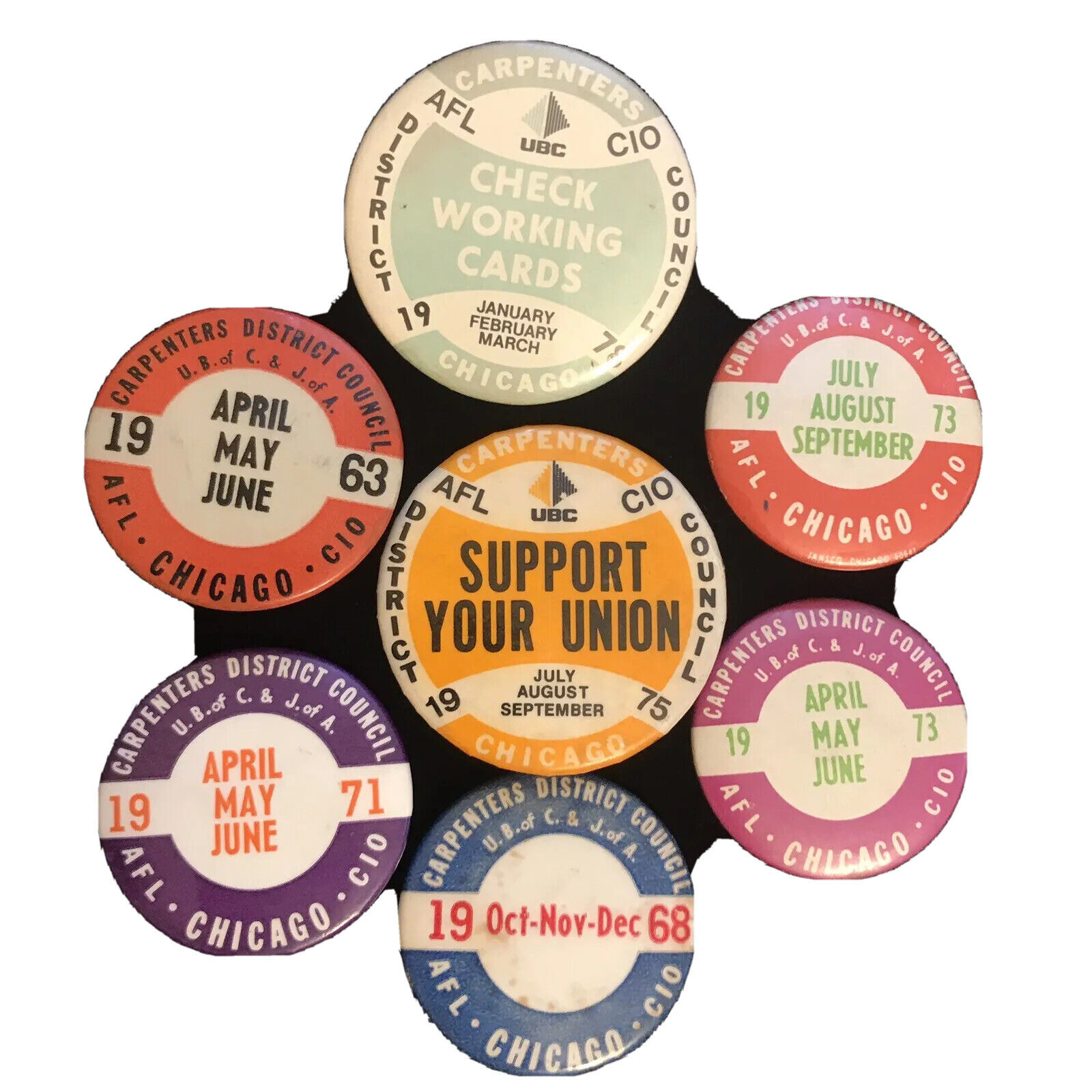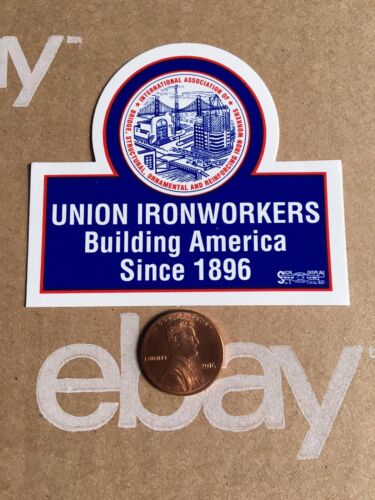-40%
Carpenter Union Pin Lot Chicago Buttons Labor
$ 7.89
- Description
- Size Guide
Description
1963 AFL CIO CHICAGO 1.5" Pinback Button - GREEN DUCK Co. CHICAGO on rim.• 1968
• 1971
• 1973 (x2)
• 1975 (1-3/4”)
• 1978 (1-3/4”)
• JANSCO CHICAGO 6064
• #483
Carpenters Union Dues Pin .
The United Brotherhood of Carpenters and Joiners of America often simply, the United Brotherhood of Carpenters (UBC)[2] was formed in 1881 by Peter J. McGuire and Gustav Luebkert. It has become one of the largest trade unions in the United States, and through chapters, and locals, there is international cooperation that poises the brotherhood for a global role. For example, the North American Chapter has over 520,000 members throughout the continent.
The union was created in August 12 1881, by Peter J. McGuire and Gustav Luebkert. The two men organized groups for collective bargaining, and started a newspaper called The Carpenter to facilitate their idea of a national union. The Brotherhood held its first convention in Chicago in August 1881. The cornerstone of local and regional affiliations in support of common goals was laid out to show ways to maximize the unions bargaining potential. The immediate common goals were wage and hour demands, and death and sickness benefits. The union grew from its 1881 membership of 2000, to 50,000 by 1890, and 100,000 by 1900.
While Peter N. McGuire was a socialist, the union itself was non-political, refusing to endorse any political party or philosophy. It was not, on the other hand, apolitical: it supported legislation establishing the eight-hour day.
The union also struck to obtain the eight-hour day, calling a strike of its affiliates for May 1, 1886. The strike itself was ineffective and provoked a repressive response, particularly in Chicago, where police shot and killed two strikers two days later, leading to the Haymarket Riot the following day.
Even so, the strike gave the Brotherhood added visibility that led to increased membership. The union struck again in 1890, with similarly uneven results, but now facing the stiffened resistance of newly formed employers associations.
The Brotherhood admitted both black and white carpenters on an equal footing when it was first formed; one of the union's vice-presidents in its early years was L.E. Rames, an African-American carpenter from Charleston, South Carolina. In the South, however, the union often isolated black carpenters in segregated locals as a concession to the opposition of white carpenters and contractors. Local unions also often excluded black workers on a de facto basis. The union formally dissolved its segregated locals in 1963.
The union also faced fierce pressures from outside to exclude black carpenters: in 1919 supervisors from the Great Southern Lumber Company, the mayor of Bogalusa, Louisiana, and local businessmen affiliated with the Ku Klux Klan, attacked and killed four union organizers who had attempted to organize black and white lumber mill workers. None of the attackers were convicted of any crimes.
Condition is Used.
The Carpenters, like other building trades, had not faced serious employer opposition since the 1920s. This changed in the 1970s as the Business Roundtable, made up of the heads of General Motors, General Electric, Exxon, U.S. Steel, DuPont and others, undertook a program to reduce building costs by replacing unionized with non-union contractors. The Roundtable also attempted to weaken the Davis-Bacon Act and other legislation that protected construction workers. The building trades, caught off guard and used to organizing from the top down, lost large amounts of work to non-union contractors in the decades that followed.
The Carpenters were formerly, like most other craft unions coming out of the AFL, a union that allowed its Locals substantial autonomy in bargaining and representing their members. The Carpenter's International began to consolidate Locals into a District Council system in 1988 and since the International Convention of 2000, a system of "Regional Councils" has been implemented, further reducing the number of districts and high ranking Board members from 13 down to 10. While it may be debatable whether McCarron's vision is better or worse for the International Carpenters Union as a whole, they are one of only a very few International Unions in America whose membership has been maintained or grown while most other Unions have seen large declines in membership.
Consolidation of Locals was to address the regionalization of the contracting industry. The contractor who only worked within the local area was quickly becoming a thing of the past, while non-Union contractors were free to move their crews - experienced with the company's methods of operation - from job to job, Union Contractors could not move their workers beyond the borders of the District's jurisdictional boundaries without replacing their crews with new carpenters from the jurisdictional district outside the Contractor's home Council. Union contractors rightfully claimed the situation was making them less competitive than the non-Union crews, and the 50% rule was adopted. Union contractors may now use crews with one local Carpenter for each Company Carpenter on jobs outside their Region. The consolidation greatly expanded the boundaries of a Regional Council's jurisdiction and left the consolidated areas with a larger Council better able to compete with the growing non-Union segment of specialized contractors. Because of the pervasive protectionism practiced by the Locals, free movement of workers within a Council was only possible after this authority was taken from the Locals and given to the Councils in the 1991 UBC Convention.) Within this new system, working Carpenters slowly lost the right to vote for their Local's Business Agents and Organizers, thus consolidating all power into the Regional Council's officers and leaving Locals and rank and file members to vote on Delegate to the intermediary Regional Councils. As the union began reorganizing its system of District Councils to give more power to Regional Councils, it consolidated Locals into fewer Charters and deprived local members of the right to vote on contract ratification, giving into the hands of the Regional Council Delegates as the contracts also expanded covering greater areas than a single Local. However, all contracts are voted on by the rank and file members of the various locals belonging to the Northern California Carpenter's Regional Council.
A Federal Court of Appeals first questioned, then approved the United States Department of Labor's failure to treat these Councils as "local unions" for purposes of the Labor Management Reporting and Disclosure Act's requirements governing local union elections, the Department has announced its intent to reconsider its existing regulations on this issue.
The Carpenters disaffiliated from the AFL-CIO in 2001, citing complaints about the National Federation's failure to follow up on its program to organize the unorganized. Other observers attributed the Carpenters' departure to its unhappiness with jurisdictional awards and other restrictions on its ability to raid the jurisdictions of other unions, as well as the AFL-CIO's uncritical and exclusive support of the Democratic Party.
Even after it left the federation, however, the Carpenters formed a temporary alliance, the New Unity Partnership in 2003 and the Change to Win Coalition with other unions — including SEIU, UNITE HERE, and the Laborers — to force the AFL-CIO to consider basic structural changes in order to facilitate organizing. In the summer of 2009, the United Brotherhood of Carpenters disaffiliated from Change to Win after the other affiliates in the Change to Win Coalition demanded the Carpenters cease raiding other Union's membership and allow Carpenter members basic democratic rights.[4]
Shipped with USPS First Class Package.




















